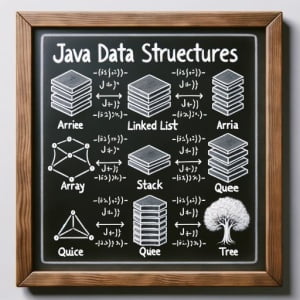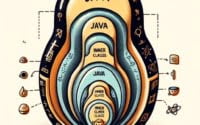Java Data Structures | 2024 Guide

Ever find it hard to decide which data structure to use in Java? You’re not alone. Java’s data structures are each designed for a specific task, but you’ve got to pick the best tool for the job.
This guide will help you understand and master Java’s built-in data structures. We’ll cover everything from the basics to more advanced structures, as well as alternative approaches and troubleshooting common issues.
So, let’s dive in!
TL;DR: What Are the Main Data Structures in Java?
Java provides a variety of data structures through its Collections Framework, including
ArrayList, LinkedList, Stack, Queue, HashSet, HashMap, TreeSet, TreeMap, and PriorityQueue. Each of these has its own strengths and weaknesses, and is suited to different tasks.
Here’s a simple example of how to create a list of elements where duplicates are allowed using ArrayList:
List<String> list = new ArrayList<>();
list.add("Hello");
list.add("World");
// Output:
// [Hello, World]
In this example, we’ve created an ArrayList and added two elements to it. The ArrayList allows duplicates and maintains the insertion order, so when we print the list, it outputs the elements in the order they were added.
This is just a basic way to use data structures in Java, but there’s much more to learn about using and choosing the right data structure for your specific needs. Continue reading for a more detailed guide on Java data structures.
Table of Contents
Basic Java Data Structures: ArrayList, LinkedList, Stack, and Queue
ArrayList
ArrayList is one of the most commonly used data structures in Java. It’s a dynamic array that can grow and shrink in size automatically. It allows you to store any number of elements and can contain duplicates.
Here’s a simple example of how to use ArrayList:
List<String> arrayList = new ArrayList<>();
arrayList.add("Hello");
arrayList.add("Java");
arrayList.add("World");
System.out.println(arrayList);
// Output:
// [Hello, Java, World]
In this example, we’ve created an ArrayList and added three elements to it. The ArrayList maintains the insertion order, so when we print the list, it outputs the elements in the order they were added.
LinkedList
LinkedList is another common data structure in Java. It’s a doubly-linked list that stores elements in nodes. Each node contains a pointer to the next node and the previous node, making it efficient for adding and removing elements in the middle of the list.
Here’s how you can use LinkedList:
List<String> linkedList = new LinkedList<>();
linkedList.add("Hello");
linkedList.add("Java");
linkedList.add("World");
System.out.println(linkedList);
// Output:
// [Hello, Java, World]
This LinkedList example works similarly to the ArrayList example. However, if we were to add or remove elements in the middle of the list, LinkedList would perform better than ArrayList.
Using Stacks
A Stack is a Last-In-First-Out (LIFO) data structure. It’s like a stack of plates; the last plate put on the stack is the first one to be used.
Here’s an example of a Stack in action:
Stack<String> stack = new Stack<>();
stack.push("Hello");
stack.push("Java");
stack.push("World");
System.out.println(stack.pop());
// Output:
// World
In this example, we add three elements to the Stack. When we call the pop method, it removes and returns the last element that was added to the Stack, which is “World”.
Queuing with Queue
A Queue is a First-In-First-Out (FIFO) data structure. It’s like a real-world queue; the first person who joins the queue is the first one to leave.
Here’s how you can use a Queue in Java:
Queue<String> queue = new LinkedList<>();
queue.add("Hello");
queue.add("Java");
queue.add("World");
System.out.println(queue.poll());
// Output:
// Hello
In this Queue example, we add three elements to the Queue. When we call the poll method, it removes and returns the first element that was added to the Queue, which is “Hello”.
These are just the basic data structures in Java. Each has its use cases and understanding when to use which is crucial in programming. As you delve deeper into Java, you’ll encounter more complex data structures that offer greater flexibility and efficiency.
Advanced Java Data Structures: HashSet, HashMap, and More
HashSet: Unique Elements Only
HashSet is a collection that doesn’t allow duplicate elements. It’s especially useful when you want to keep track of unique elements.
Here’s an example of how to use a HashSet:
Set<String> hashSet = new HashSet<>();
hashSet.add("Hello");
hashSet.add("Java");
hashSet.add("Java");
System.out.println(hashSet);
// Output:
// [Hello, Java]
In this example, we’ve attempted to add “Java” twice to the HashSet. However, when we print the HashSet, it only contains one instance of “Java” because HashSet doesn’t allow duplicates.
HashMap: Key-Value Pairs
HashMap is a collection that stores elements as key-value pairs. It allows you to retrieve a value quickly if you know its key.
Here’s how to use a HashMap:
Map<String, String> hashMap = new HashMap<>();
hashMap.put("Language", "Java");
hashMap.put("Version", "11");
System.out.println(hashMap.get("Language"));
// Output:
// Java
In this example, we’ve stored two key-value pairs in the HashMap. When we retrieve the value with the key “Language”, it returns “Java”.
TreeSet: Sorted Unique Elements
TreeSet is a collection that stores unique elements in a sorted order. It’s useful when you need to maintain a sorted set of unique elements.
Here’s an example of a TreeSet:
Set<String> treeSet = new TreeSet<>();
treeSet.add("Hello");
treeSet.add("Java");
treeSet.add("World");
System.out.println(treeSet);
// Output:
// [Hello, Java, World]
In this example, we’ve added three elements to the TreeSet. When we print the TreeSet, it outputs the elements in ascending order.
TreeMap: Sorted Key-Value Pairs
TreeMap is a collection that stores key-value pairs in a sorted order. It’s a good choice when you need to maintain a sorted map.
Here’s how to use a TreeMap:
Map<String, String> treeMap = new TreeMap<>();
treeMap.put("Language", "Java");
treeMap.put("Version", "11");
System.out.println(treeMap.get("Language"));
// Output:
// Java
This TreeMap example works similarly to the HashMap example. However, if we were to print the entire map, TreeMap would output the key-value pairs in ascending order of the keys.
PriorityQueue: Priority Elements
PriorityQueue is a collection that orders its elements based on their natural ordering or a custom comparator. It’s useful when you need to process elements based on their priority.
Here’s an example of a PriorityQueue:
Queue<String> priorityQueue = new PriorityQueue<>();
priorityQueue.add("Hello");
priorityQueue.add("Java");
priorityQueue.add("World");
System.out.println(priorityQueue.poll());
// Output:
// Hello
In this PriorityQueue example, we add three elements to the queue. When we call the poll method, it removes and returns the element with the highest priority, which in this case is “Hello” because it comes first in alphabetical order.
Understanding these advanced data structures and when to use them can significantly improve your efficiency in Java programming. Each has its strengths and weaknesses, and the right choice depends on the specific requirements of your task.
Alternative Java Data Structures
Java’s built-in data structures cover a wide range of use cases, but sometimes you might need something a bit different. There are less commonly used data structures in Java and data structures provided by external libraries that can offer more unique and specialized functionality.
Vector: A Thread-Safe ArrayList
Vector is similar to ArrayList, but it’s thread-safe. This means multiple threads can modify a Vector without causing concurrency issues. However, this comes at the cost of performance.
Here’s an example of how to use a Vector:
List<String> vector = new Vector<>();
vector.add("Hello");
vector.add("Java");
vector.add("World");
System.out.println(vector);
// Output:
// [Hello, Java, World]
In this example, we’ve used a Vector in the same way as an ArrayList. The difference is that Vector is thread-safe.
LinkedHashMap: A HashMap with Insertion Order
LinkedHashMap is similar to HashMap, but it maintains the insertion order of the entries. This means when you iterate over the entries, they will be returned in the order they were inserted.
Here’s how to use a LinkedHashMap:
Map<String, String> linkedHashMap = new LinkedHashMap<>();
linkedHashMap.put("Language", "Java");
linkedHashMap.put("Version", "11");
System.out.println(linkedHashMap);
// Output:
// {Language=Java, Version=11}
In this example, we’ve used a LinkedHashMap to store two key-value pairs. When we print the map, it outputs the entries in the order they were inserted.
External Libraries: Guava and Apache Commons Collections
There are also external libraries like Google’s Guava and Apache Commons Collections that provide additional data structures. These libraries offer a variety of specialized data structures that can be useful in certain scenarios.
For example, Guava provides a Multimap which allows you to map a key to multiple values. Here’s an example:
Multimap<String, String> multimap = ArrayListMultimap.create();
multimap.put("Languages", "Java");
multimap.put("Languages", "Python");
System.out.println(multimap.get("Languages"));
// Output:
// [Java, Python]
In this example, we’ve used Guava’s Multimap to map the key “Languages” to two values, “Java” and “Python”. When we retrieve the values with the key “Languages”, it returns both “Java” and “Python”.
Choosing the right data structure can have a significant impact on the performance and readability of your code. While Java’s built-in data structures are sufficient for most tasks, it’s good to be aware of these alternative approaches for those special cases.
Troubleshooting Common Issues
While working with Java data structures, you might encounter some common issues. Understanding these issues and knowing how to solve them is crucial for efficient programming.
Duplicate Elements in a Set
One common mistake is expecting a Set to contain duplicate elements. Remember, a Set (like HashSet or TreeSet) does not allow duplicates. If you try to add a duplicate element to a Set, it will not throw an error, but the duplicate will not be added.
Set<String> set = new HashSet<>();
set.add("Java");
set.add("Java");
System.out.println(set);
// Output:
// [Java]
In this example, we’ve tried to add “Java” twice to the HashSet. However, when we print the HashSet, it only contains one instance of “Java”.
Null Elements in a List or a Set
Another common mistake is trying to add null elements to a data structure that doesn’t allow nulls (like PriorityQueue). If you try to add a null element, it will throw a NullPointerException.
Queue<String> queue = new PriorityQueue<>();
queue.add(null);
// Output:
// Exception in thread "main" java.lang.NullPointerException
In this example, we’ve tried to add a null element to a PriorityQueue, which throws a NullPointerException.
Concurrent Modification
Concurrent modification is a common issue when working with Java’s collection classes. If one thread modifies a collection while another thread is iterating over it, a ConcurrentModificationException may be thrown.
List<String> list = new ArrayList<>(Arrays.asList("Hello", "Java"));
for (String element : list) {
list.remove(element);
}
// Output:
// Exception in thread "main" java.util.ConcurrentModificationException
In this example, we’ve tried to remove an element from an ArrayList while iterating over it, which throws a ConcurrentModificationException.
To avoid this issue, you can use an Iterator to safely remove elements while iterating.
List<String> list = new ArrayList<>(Arrays.asList("Hello", "Java"));
Iterator<String> iterator = list.iterator();
while (iterator.hasNext()) {
String element = iterator.next();
iterator.remove();
}
System.out.println(list);
// Output:
// []
In this example, we’ve used an Iterator to safely remove all elements from the ArrayList while iterating over it.
These are some of the common issues you might encounter while working with Java data structures. By understanding these issues and knowing how to solve them, you can avoid common pitfalls and write more robust code.
Understanding Data Theory
Data structures are a fundamental concept in computer science, and they play a vital role in Java programming. They are essentially containers that store data in a specific layout. This layout not only defines how data is stored but also how operations are performed on the data.
What are Data Structures?
Data structures are all about organizing and storing data. The way data is organized can have a profound impact on performance and capabilities. Data structures provide a means of managing large amounts of data efficiently for uses such as large databases and internet indexing services.
// An example of a simple data structure is an array, which stores data elements in a linear format.
int[] array = new int[5];
array[0] = 1;
array[1] = 2;
array[2] = 3;
array[3] = 4;
array[4] = 5;
System.out.println(Arrays.toString(array));
// Output:
// [1, 2, 3, 4, 5]
In this example, we’ve created an array of integers. This is a simple data structure where each element can be accessed directly through its index.
How are Data Structures Implemented in Java?
Java provides a rich set of built-in data structures through its Collections Framework. These data structures include ArrayList, LinkedList, Stack, Queue, HashSet, HashMap, TreeSet, TreeMap, and PriorityQueue, among others.
Each of these data structures has a different layout and is suitable for different kinds of tasks. For example, an ArrayList is an array-based list that provides fast access to elements, while a LinkedList is a doubly-linked list that provides fast insertion and deletion.
// An example of using an ArrayList and LinkedList in Java.
List<String> arrayList = new ArrayList<>();
arrayList.add("Hello");
arrayList.add("Java");
System.out.println(arrayList);
List<String> linkedList = new LinkedList<>();
linkedList.add("Hello");
linkedList.add("Java");
System.out.println(linkedList);
// Output:
// [Hello, Java]
// [Hello, Java]
In these examples, we’ve created an ArrayList and a LinkedList and added two elements to each. Both lists output the same elements, but the underlying data structures are different.
Understanding the theory behind data structures and how they are implemented in Java is crucial for writing efficient code. By choosing the right data structure for a task, you can write code that is faster, more efficient, and easier to understand.
Practical Application
Data structures in Java are not just theoretical concepts; they find extensive use in real-world applications and projects. For instance, ArrayLists and HashMaps are commonly used in web applications for storing user data and session information. Stacks and Queues find their use in algorithmic problems and are extensively used in system designs.
// A simple web session represented using HashMap
Map<String, Object> session = new HashMap<>();
session.put("userId", 123);
session.put("userName", "John Doe");
session.put("isLoggedIn", true);
System.out.println(session);
// Output:
// {userId=123, userName=John Doe, isLoggedIn=true}
In this example, we’ve simulated a web session using a HashMap. The keys represent the session attributes, and the values represent the respective attribute values.
Data Structures in Algorithm Design
Data structures also play a crucial role in algorithm design. Different algorithms require different data structures, and choosing the right one can significantly improve the algorithm’s performance. For example, Breadth-First Search (BFS) uses a Queue, while Depth-First Search (DFS) uses a Stack.
// A simple BFS algorithm using a Queue
Queue<Node> queue = new LinkedList<>();
queue.add(startNode);
while (!queue.isEmpty()) {
Node node = queue.poll();
// process node
for (Node neighbor : node.getNeighbors()) {
queue.add(neighbor);
}
}
In this example, we’ve outlined a simple BFS algorithm using a Queue. The Queue ensures that we process the nodes in the order they were discovered.
Further Resources and Links
If you’re interested in diving deeper into Java data structures, here are some resources that you might find helpful:
- Discovering Java’s Potential: What Is It Used For? – Discover how Java enables real-time communication applications.
Data Types in Java Explained – Master handling data effectively using various data types in Java.
Java Classes Overview – Understand the concept of classes as blueprints for objects in Java.
Java 11 & Java 17 Programming Masterclass on Udemy covers Java in great detail, including a section on data structures.
Java Data Structures and Algorithms on Coursera focuses specifically on data structures and algorithms in Java.
Java Data Structures on Oracle’s Official Java Documentation covers all the built-in data structures in detail.
Remember, mastering data structures requires practice. The more you code, the more comfortable you’ll become with choosing and using the right data structure.
Wrapping Up
In this comprehensive guide, we’ve delved into the world of Java data structures, exploring how to use, understand, and master them for efficient programming.
We began with the basics, discussing commonly used data structures like ArrayList, LinkedList, Stack, and Queue. We then ventured into more advanced territory, exploring complex data structures such as HashSet, HashMap, TreeSet, TreeMap, and PriorityQueue. Along the way, we tackled common challenges you might face when working with Java data structures, providing you with solutions and workarounds for each issue.
We also looked at alternative approaches, discussing less commonly used data structures in Java and those provided by external libraries. These alternatives can offer more unique and specialized functionality, providing more tools in your programming toolbox.
Here’s a quick comparison of some of the data structures we’ve discussed:
| Data Structure | Primary Use | Pros | Cons |
|---|---|---|---|
| ArrayList | Dynamic array | Fast access to elements | Slow insertion and deletion |
| LinkedList | Doubly-linked list | Fast insertion and deletion | Slow access to elements |
| HashSet | Unique elements | Fast operations | No order |
| HashMap | Key-value pairs | Fast operations | No order |
| TreeSet | Sorted unique elements | Sorted order | Slower operations |
Whether you’re just starting out with Java or looking to level up your data structures knowledge, we hope this guide has given you a deeper understanding of Java data structures and their capabilities.
Mastering data structures is a fundamental step to becoming a proficient Java programmer. With this guide, you’re well on your way to achieving that. Happy coding!


